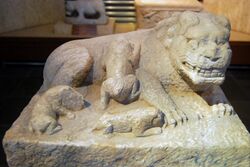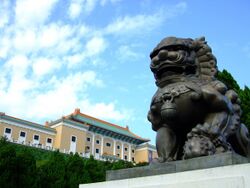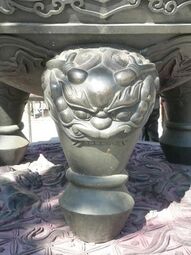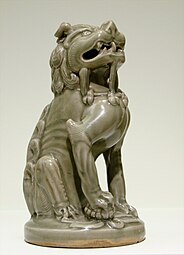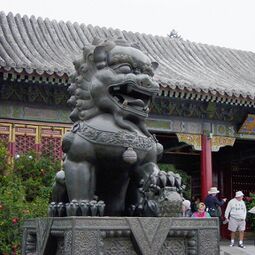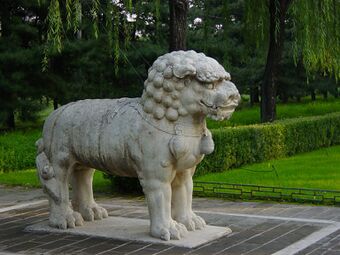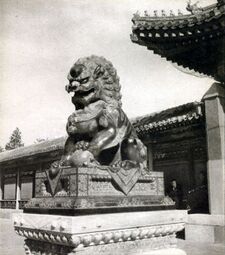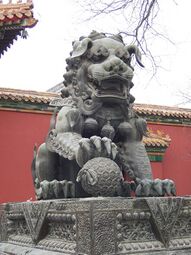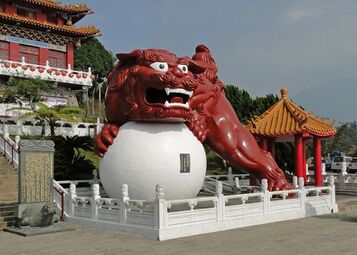Unsolved:Chinese guardian lions
| Chinese guardian lions |
|---|
Chinese guardian lions or Imperial guardian lions, often miscalled "Foo Dogs" in the West, are a common representation of the lion in imperial China. Chinese guardian lions are sometimes referred to in English as shishi, from the Chinese shí shī (Chinese: 石獅; pinyin: shíshī; literally: 'stone lion'), which refers specifically to lion sculptures in stone. The concept, which originated and became popular in Chinese Buddhism, subsequently spread to other parts of Asia including, Japan, Korea, Tibet, Thailand, Burma, Vietnam, Sri Lanka, Nepal, Cambodia, Laos and Singapore.[1]
Description
Since the introduction of the lion symbolism from Indian culture especially through Buddhist symbolism, statues of guardian lions have traditionally stood in front of China Imperial palaces, Imperial tombs, government offices, temples, and the homes of government officials and the wealthy, from the Han dynasty (206 BC – AD 220), and were believed to have powerful mythic protective benefits. They are also used in other artistic contexts, for example on door-knockers, and in pottery. Pairs of guardian lion statues are still common decorative and symbolic elements at the entrances to restaurants, hotels, supermarkets and other structures, with one sitting on each side of the entrance, in China and in other places around the world where the Chinese people have immigrated and settled, especially in local Chinatowns.
The lions are usually depicted in pairs. When used as statuary the pair would consist of a male leaning his paw upon an embroidered ball (in imperial contexts, representing supremacy over the world ) and a female restraining a playful cub that is on its back (representing nurture ).[2]
Etymology
Guardian lions are referred to in various ways depending on language and context. In Chinese they are traditionally called simply shi (獅, Pinyin: shī) meaning lion—the word shi itself is thought to be derived from the Persian word šer.[3] Lions were first presented to the Han court by emissaries from Central Asia and Persia, and by the sixth century AD they were already popularly depicted as guardian figures.[4] Today the guardian lions are more usually specified by reference to the medium or material, for example:
- Stone lion (石獅, Pinyin: Shíshī): for a stone sculpture; or
- Bronze lion (銅獅, Pinyin: Tóngshī): for a bronze sculpture.
and less commonly:
- Auspicious lion (瑞獅, Pinyin: Ruìshī): referring to the Tibetan Snow Lion or good fortune
- Fortuitous lion (福獅, Pinyin: fúshī)[citation needed]: referring to good fortune
- Buddha's or Buddhist lion (佛獅, Pinyin: fóshī)[citation needed]: referring in a religious context to the lion as protector of Buddha
In other Asian cultures
- In Japan : the lion figures are known as Shishi (獅子, lion) or Komainu (狛犬, lion dogs)
- In Korea: known as Haetae
- In Myanmar, Laos and Cambodia: known as Chinthe and gave their name to the World War II Chindit soldiers
- In Okinawa, Japan: known as Shisa
- In Sri Lanka: known as Simha (සිංහ මූර්ති)
- In Thailand: known as Singha
- In Tibet: known as a Snow Lion
- In Vietnam: known as Sư tử đá
Western names
In English and several Western languages, the guardian lions are often referred in a multitude of name such as: "Fu Dogs",[5] "Foo Dogs", "Fu Lions", "Fo Lions", and "Lion Dogs".[6] The term "Fo" or "Fu" may be transliterations to the words 佛 (pinyin: fó) or 福 (pinyin: fú), which means "Buddha" or "prosperity" in Chinese, respectively. However, Chinese reference to the guardian lions are seldom prefixed with 佛 or 福, and more importantly never referred to as "dogs".
Reference to guardian lions as dogs in Western cultures may be due to the Japanese reference to them as "Korean dogs" (狛犬・高麗犬) due to their transmission from China through Korea into Japan. It may also be due to the misidentification of the guardian lion figures as representing certain Chinese dog breeds such as the Chow Chow (鬆獅犬, Pinyin: sōngshī quǎn, lit. "puffy-lion dog") or Pekingese (獅子狗; Pinyin: Shīzi Gǒu, lit. "lion dog").
Appearance
The lions are traditionally carved from decorative stone, such as marble and granite or cast in bronze or iron. Because of the high cost of these materials and the labor required to produce them, private use of guardian lions was traditionally reserved for wealthy or elite families. Indeed, a traditional symbol of a family's wealth or social status was the placement of guardian lions in front of the family home. However, in modern times less expensive lions, mass-produced in concrete and resin, have become available and their use is therefore no longer restricted to the elite.[citation needed]
The lions are always presented in pairs, a manifestation of yin and yang, the female representing yin and the male yang.[citation needed] The male lion has its right front paw on a type of cloth ball[citation needed] simply called an "embroidered ball" (xiù qiú, 绣球), which is sometimes carved with a geometric pattern.[citation needed] The female is essentially identical, but has a cub under the left paw, representing the cycle of life.[citation needed] Symbolically, the female lion protects those dwelling inside (the living soul within)[citation needed], while the male guards the structure (the external material elements)[citation needed]. Sometimes the female has her mouth closed, and the male open[citation needed]. This symbolizes the enunciation of the sacred word "om"[citation needed]. However, Japanese adaptations state that the male is inhaling, representing life, while the female exhales, representing death[citation needed]. Other styles have both lions with a single large pearl in each of their partially opened mouths[citation needed]. The pearl is carved so that it can roll about in the lion's mouth but sized just large enough so that it can never be removed.[citation needed]
According to feng shui, correct placement of the lions is important to ensure their beneficial effect.[citation needed] When looking at the entrance from outside the building, facing the lions, the male lion with the ball is on the right, and the female with the cub is on the left.[citation needed]
Chinese lions are intended to reflect the emotion of the animal as opposed to the reality of the lion.[citation needed] This is in distinct opposition to the traditional English lion which is a lifelike depiction of the animal.[citation needed] The claws, teeth and eyes of the Chinese lion represent power.[citation needed] Few if any muscles are visible in the Chinese lion [citation needed] whereas the English lion shows its power through its life-like characteristics rather than through stylized representation.[citation needed]
History
Asiatic lions were once quite common throughout their historic range in Southwest, South and Central Asia and are believed to be the ones depicted by the guardian lions in Chinese culture.[7] In India , where the Asiatic lion also lived, it is known by its ancient Sanskrit name "Sinh" or "Simha" (सिंह) and due to travels of Buddhist monks many East Asian languages have borrowed from this Sanskrit word for lion. Since ancient times Lion statues adorned palaces and temples and other important buildings in India and in Buddhist culture Lion was depicted as the protector of Dharma. In Hinduism lions are associated with Gods and Goddesses.
With increased trade during the Han dynasty and cultural exchanges through the Silk road, lions were introduced into China from the ancient states of Central Asia by peoples of Sogdiana, Samarkand, and the Yuezhi (月氏) in the form of pelts and live tribute, along with stories about them from Buddhist priests and travelers of the time.[8] This exchange can be seen in that the Chinese word for lion is "Shi" (師, later 獅/狮), which shares the same etymological roots as "Shiar" (شیر)/šer[3], the Persian language name for the animal.
Several instances of lions as imperial tributes from Central Asia were recorded in the document Book of the Later Han (後漢書) written from 25-220 CE. On one particular event, on the eleventh lunar month of 87 CE, "... an envoy from Parthia offered as tribute a lion and an ostrich"[9] to the Han court. Indeed, the lion was associated by the Han Chinese to earlier venerated creatures of the ancient Chinese, most notably by the monk Huilin (慧琳) who stated that "the mythic suan-ni (狻猊) is actually the lion, coming from the Western Regions" (狻猊即狮子也,出西域).[10]
The Buddhist version of the Lion was originally introduced to Han China as the protector of dharma and these lions have been found in religious art as early as 208 BC. Gradually they were incorporated as guardians of the Chinese Imperial dharm. Lions seemed appropriately regal beasts to guard the emperor's gates and have been used as such since. There are various styles of guardian lions reflecting influences from different time periods, imperial dynasties, and regions of China. These styles vary in their artistic detail and adornment as well as in the depiction of the lions from fierce to serene.
Although the form of the Chinese guardian lion was quite varied during its early history in China, the appearance, pose, and accessories of the lions eventually became standardized and formalized during the Ming and Qing dynasties into more or less its present form.
Gallery
A sitting lion statue, celadon, 11th to 12th century, Song Dynasty
Female guardian lion with her cub at the Summer Palace, Beijing- late Qing Dynasty, but in the Ming style
Imperial guardian lion outside Ngee Ann City in Singapore
Guardian Lion, Brooklyn Museum, New York City
Guardian Lion in Saint Petersburg, Russia
Literary references
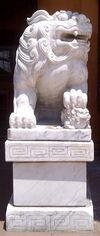

- In the novelet "White Magic" by Albert E. Cowdrey (Magazine of Fantasy & Science Fiction, March 1998), the protagonist has a "foo" lion/dog that serves as his "familiar" and comes alive, when necessary, to protect him and his neighbors.
- In the planned spinoffs of the comics based on the Gargoyles Disney TV animated series, the "timedancing" gargoyle Brooklyn receives a green-skinned, leonine gargoyle beast that is named "fu-dog" from the Western name of the guardian lion statuary.
- Stone lions feature in a well-known Chinese tongue-twister: 四 是 四 , 十 是 十 , 十 四 是 十 四 , 四 十 是 四 十 , 四 十 四 只 石 狮 子 是 死 的。
(pinyin:) sì shì sì, shí shì shí, shí sì shì shí sì, sì shí shì sì shí, sì shí sì zhī shí shī zì shì sǐ de. (4 is 4, 10 is 10, 14 is 14, 40 is 40, 44 stone lions are dead.)
- In The Dresden Files series by Jim Butcher, the protagonist Harry Dresden comes into possession of a "Tibetan Temple Dog", frequently also referred to as a Foo Dog or Foo Spirit. Named "Mouse", he is depicted as an unusually large mastiff-like dog with human level intelligence, remarkable resilience and strength, as well as the ability to perceive and attack spirits and non-corporeal beings.
- In Richard Russo's novel Nobody's Fool, Miss Beryl Peoples owns a two-headed "foo dog" she purchased while travelling the Orient. Miss Beryl claims it is called a "foo" dog because the dog says, "Foo on you!" when he is not approving of a person's actions.
See also
- Komainu to compare its use in Japanese culture
- Qilin, another mythical creature in Chinese culture
- Sphinx
- Chinthe similar lion statues in Burma, Laos and Cambodia
- Shisa similar lion statues in the Ryukyu Islands
- Nian to compare with a similar but horned (unicorn) mythical beast
- Pixiu to compare with a similar but winged mythical beast
- Haetae to compare with similar lion-like statues in Korea.
- Foo dog, dog breeds originating in China that resemble "Chinese guardian lions" and hence are also called Lion Dogs.
- Asiatic lions found in nearby India are the ones depicted in the Chinese culture.
- Piraeus Lion
- Tibetan Snow Lion
- Traditional Chinese Lions (Indianapolis Zoo)
- Medici lions
- Lion dance, another use of lion imagery in costume and motion.
- Culture of China
- Chinese mythology
- Chinese dragon
- Door god
References
- ↑ By K Gorman. "Monster Monday: Guardian Lions – K. Gorman". Kgorman.ca. http://kgorman.ca/monster-monday-guardian-lions/. Retrieved 2018-04-04.
- ↑ "Lion of Fo – Chinese art". britannica.com. http://www.britannica.com/EBchecked/topic/342714/Lion-of-Fo.
- ↑ 3.0 3.1 Laurence E. R. Picken (1984). Music for a Lion Dance of the Song Dynasty. Musica Asiatica: volume 4. Cambridge University Press. p. 201. ISBN 978-0-521-27837-9. https://books.google.com/books?id=Xy45AAAAIAAJ&pg=PA201&f=false#v=onepage&q&f=false.
- ↑ Marianne Hulsbosch, Elizabeth Bedford, Martha Chaiklin, ed (2010). Asian Material Culture. Amsterdam University Press. p. 109. https://books.google.com/books?id=PcvA373XEJwC&pg=PA109&f=false#v=onepage&q&f=false.
- ↑ D. Eastlake, C. Manros, and E. Raymond, RFC 3092: Etymology of "Foo", The Internet Society, April 1, 2001.
- ↑ Article Lion of Fo at the Online version of Encyclopædia Britannica.
- ↑ "The Sunday Tribune – Spectrum – 'Art and Soul". tribuneindia.com. http://www.tribuneindia.com/2002/20021006/spectrum/art.htm.
- ↑ Schafer, Edward H. (1963). The Golden Peaches of Samarkand, a Study of T'ang Exotics. University of California Press.
- ↑ "安息國遣使獻師子及條枝大爵" 後漢書, 和帝, Scroll 4
- ↑ "狻猊_神兽狻猊_狻猊怎么读_狻猊的故事". fantizi5.com. http://www.fantizi5.com/shenshou/longjiuzi/suanni/.
External links
- Foo Dog in Tattoo Art. Meaning and Design Ideas.
- A blog about the adventures of a Foo Dog statue all over the United States.
- Netsuke: masterpieces from the Metropolitan Museum of Art, an exhibition catalog from The Metropolitan Museum of Art (fully available online as PDF), which contains many representations of Chinese guardian lions
